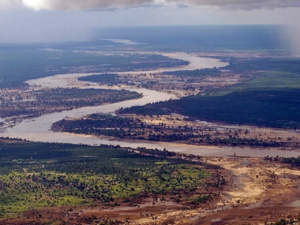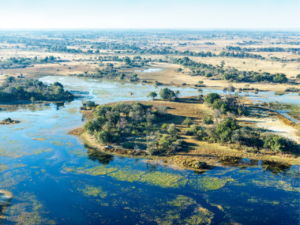With 63 international river basins and 90% of Africa’s surface water shared across borders, transboundary water agreements are vital to manage resources, mitigate conflicts, and ensure equitable access.
Water disregards borders, but people don’t. Shared river basins in Africa necessitate transboundary water agreements. Crucial for co-operation and peace, these agreements ensure sustainable development by managing conflicts and promoting equitable resource use across borders.
Africa accounts for 17% of the world’s population and 9% of the global renewable water resources. The continent’s water is unevenly distributed. Six of the most water-rich countries in Central and Western Africa hold 54% of the continent’s total resources. Twenty-seven of the water-poorest countries hold only 7%. In Africa, water availability is linked to two interconnected mechanisms: Rainfall and internal resources. Where the rains are seasonal, they fill reserves and replenish groundwater and when there is no rain, there is no natural input into the water cycle.
Two-thirds of African livelihoods are found in the water-heavy sectors of agriculture and fisheries. This necessitates robust water management and because of the geographic nature of water in Africa, co-operation is imperative.
Whose borders?
Transboundary water (TBW) resources are especially important in Africa, where 63 international transboundary river basins cover about 62% of the region’s land area and account for 90% of the total surface water.
Water agreements between countries sharing a TBW resource often constitute the main governing apparatus in the use, development, and management of shared water resources. However, the last SDG indicator 6.5.2 report shows that in Africa, only 29% of transboundary river basins and fewer than 10% of transboundary aquifers are the object of TBW agreements and, of these, only 19% have any basin-wide agreements. In addition, most TBW agreements assume that future water supply and quality will not change and fail to consider increasing climate-induced water variability. Therefore, most TBW agreements lack the capacity to adapt to temporal and spatial changes in water quantity.
Existing agreements
TBW agreements in Africa often cover a range of issues such as water resources management, wildlife conservation, and regional co-operation.
Here are some notable ones:

Map showing
Africa’s key
transboundary
systems, highlighting
the Zambezi
river basin
is one of the largest and most well-defined organisations that promote cross-country co-operation with Senegal, Mali, and Mauritania. This large co-operation exists to share the transboundary river effectively across the three borders. This includes research and development but extends to diplomatic ties between nations. While the OMVS is an example of good cooperation, other organisations like the Lake Chad Basin Commission, which facilitates co-operation between Cameroon, Chad, Central African Republic, Libya, Niger, and Nigeria are an example of uniting under differences.
Lake Chad has been subject to damming, over-extraction, droughts, and the effects of climate change which have decreased its size by 90% in sixty years. Member states have placed their faith in the LCBC to co-ordinate development and mediate disputes.
The Orange-Senqu River Commission (ORASECOM) houses Botswana, Namibia, and South Africa as member states and has recently taken more initiative in transboundary cooperation.
The commission has established the Multi-Country Co-operation Mechanisms (MCCM) for the Stampriet Aquifer system. This embeds a groundwater-specific mechanism into a river basin organisation, thus facilitating the conjunctive management of surface water groundwater resources and building on already existing co-operation.
The Shire River basin (shared between Malawi and Mozambique), a surface water catchment within the Zambezi River basin, overlays two transboundary aquifers. Both countries face high levels of socio-economic instability. The lack of water access is due to insufficient flood preparedness, poor water quality, and a lack of monitoring which is exacerbated by non-co-operation between the two countries, highlighting the need for an effective transboundary agreement. This needn’t be difficult as the Shire basin forms part of the Zambesi River which already has the Zambezi Watercourse Convention (ZWC) that mediates between Angola, Botswana, Malawi, Mozambique, Namibia, Tanzania, Zambia, and Zimbabwe.
South Africa

Another important organising body is the
Limpopo Watercourse Commission (LIMCOM). They
oversee cooperation between Zimbabwe, Botswana,
Mozambique and South Africa.
Positioned as one of the more developed countries in Southern Africa, South Africa has the responsibility to be involved with many of the transboundary agreements that necessitate water sharing in the region. The Tuli Karoo Transboundary Aquifer Area shared by Botswana, South Africa, and Zimbabwe is one such case.
The South African Development Commission which oversees Tuli Karoo transboundary agreements sees a near-constant influx of additional agreements or growing agreements. Another important organising body is the
Limpopo Watercourse Commission (LIMCOM). They oversee co-operation between Zimbabwe, Botswana, Mozambique, and South Africa. In March 2024 Zimbabwe, through LIMCOM, agreed to send 15 million cubic metres per annum (m3/a) which is equal to megalitres of water per day (41 Mℓ/d) of treated water to the Musina area.
Musina Local Municipality has a total population of 132 009 residing in 192 villages and the town of Musina relies solely on groundwater. This addition is a clear example of how cross-border co-operation can help those who need it most.
Problems with existing agreements
There is a definite benefit and need for these agreements but existing agreements are not without issue. There are 63 transboundary water basins in Africa but only 14 have co-operative legal and institutional arrangements. Of these existing arrangements, five main problems constrain them:
1. Absence of a designated and mandated agency to act on behalf of the riparian countries
As noted with the Shire River basin, the existence of a transboundary basin does not mean that there is effective management. The LCBC was established as a direct response to unregulated water usage among many countries where the existence of a mandated agency would have prevented many of the problems that the LCBC is tasked with fixing today.
2. Technical and managerial weaknesses at the level of the secretariat of the basin authorities
The mere existence of an organising body is not enough, training of qualified staff is the key for any effective water management. Over and above that, these bodies need to be strong in the face of regional instability and clashes of interests.
3. Inadequate funding by member states of the basin authorities
Many transboundary agreements in Africa struggle with insufficient financial resources to implement their mandates effectively. This can limit the capacity for joint projects, infrastructure development, and management initiatives across borders.
4. Inability to mobilise external funds for pre-investment studies and investments
With water being only one of many issues in Africa, there is sometimes shortsightedness where if there isn’t a major problem right now, the future problems will be ignored for more immediate concerns. This leaves many bodies willing to help but they are financially impotent to do so.
5. Politicisation of the selection of key personnel
As with any multi-national body, various political alliances creep into and prevent effective management. This could be because of unequal member states, or over-representation of certain political ideas within an organisation.
Over and above these issues are always the issue of political instability between African countries. Rising water scarcity in Africa poses significant water management challenges.
Given the large proportion of transboundary basins in the region, mutual interests in transboundary co-operation – such as for water quality, water supply, infrastructure projects for agriculture and energy, flood control, and management of climate change impacts – can bring riparians and stakeholders together to collaboratively promote water, energy and food security. Transboundary co-operation can broaden the knowledge base, enlarge the range of measures available to mitigate water risk, increase preparedness and recovery for droughts and floods, and offer more cost-effective solutions.










